stop start PONTIAC VIBE 2004 Owners Manual
[x] Cancel search | Manufacturer: PONTIAC, Model Year: 2004, Model line: VIBE, Model: PONTIAC VIBE 2004Pages: 370, PDF Size: 2.68 MB
Page 78 of 370

Arming the System
To arm the system, do the following:
1. Turn the ignition key to the LOCK position and
remove it.
2. Have all passengers get out of the vehicle.
3. Close and lock all the side doors and liftgate with
the key or remote keyless entry transmitter.
The indicator light located
on the instrument panel to
the left of the steering
wheel will come on when
all the side doors and
liftgate are closed
and locked.
The system will be automatically set after 30 seconds.
When the system is set, the indicator light will start
¯ashing.4. After the indicator light starts ¯ashing, you may
leave the vehicle.
Do not leave anyone in the vehicle when you set
the system, because unlocking the vehicle from the
inside will activate the system.
Testing the Alarm
To test the alarm, do the following:
1. Open all the windows.
2. Set the system as described in the previous
procedure. The side doors and liftgate should
be locked with the key or remote keyless entry
transmitter. Be sure to wait until the indicator light
starts ¯ashing.
3. Unlock the driver's door from the inside. The
system should activate the alarm.
4. Stop the alarm as described in the disarming
procedure.
5. Repeat this operation for the other doors. Also
check that the system is activated when the
battery terminal is disconnected and then
reconnected.
If the system does not work properly, have it
checked by your dealer.
2-14
Page 79 of 370

How the System Alarm is Activated
The system will activate the alarm under the following
conditions:
·If the driver's or front passenger's door is unlocked
or if any of the other side doors or the liftgate is
forcibly opened without the key or remote keyless
entry transmitter.
·If the battery terminal is disconnected and then
reconnected.
·If the ignition is hot-wired.
·If the side window glass is broken or damaged.
The indicator light will come on when the system
is activated.
If the driver's or front passenger's side doors are
unlocked without using the key or remote keyless entry
transmitter, the other side doors and the liftgate will
be automatically locked again.
After one minute the alarm will automatically stop and
the indicator light will start ¯ashing again.
Reactivating the System
Once the system is set, it will automatically reset the
alarm after the alarm stops. The alarm will activate again
under the same conditions as described earlier.
Disarming the System
The alarm can be disarmed by doing one of the
following:
·Turn the ignition key from LOCK to ON.
·Unlock any of the side doors with the key or with
the remote keyless entry transmitter.
If the liftgate or liftglass is opened with the key, the
system will still be activated.
2-15
Page 80 of 370
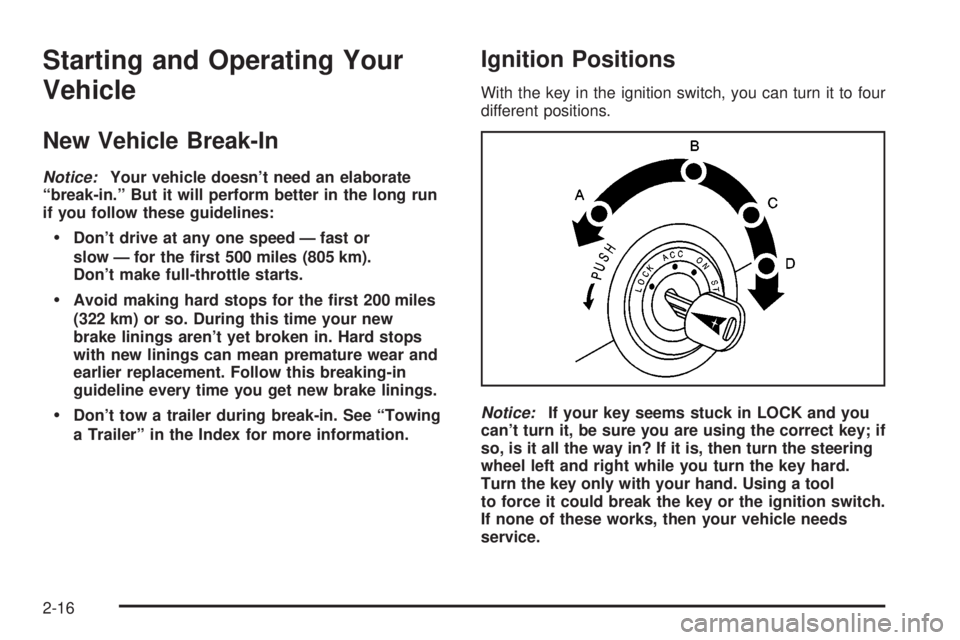
Starting and Operating Your
Vehicle
New Vehicle Break-In
Notice:Your vehicle doesn't need an elaborate
ªbreak-in.º But it will perform better in the long run
if you follow these guidelines:
·Don't drive at any one speed Ð fast or
slow Ð for the ®rst 500 miles (805 km).
Don't make full-throttle starts.
·Avoid making hard stops for the ®rst 200 miles
(322 km) or so. During this time your new
brake linings aren't yet broken in. Hard stops
with new linings can mean premature wear and
earlier replacement. Follow this breaking-in
guideline every time you get new brake linings.
·Don't tow a trailer during break-in. See ªTowing
a Trailerº in the Index for more information.
Ignition Positions
With the key in the ignition switch, you can turn it to four
different positions.
Notice:If your key seems stuck in LOCK and you
can't turn it, be sure you are using the correct key; if
so, is it all the way in? If it is, then turn the steering
wheel left and right while you turn the key hard.
Turn the key only with your hand. Using a tool
to force it could break the key or the ignition switch.
If none of these works, then your vehicle needs
service.
2-16
Page 82 of 370
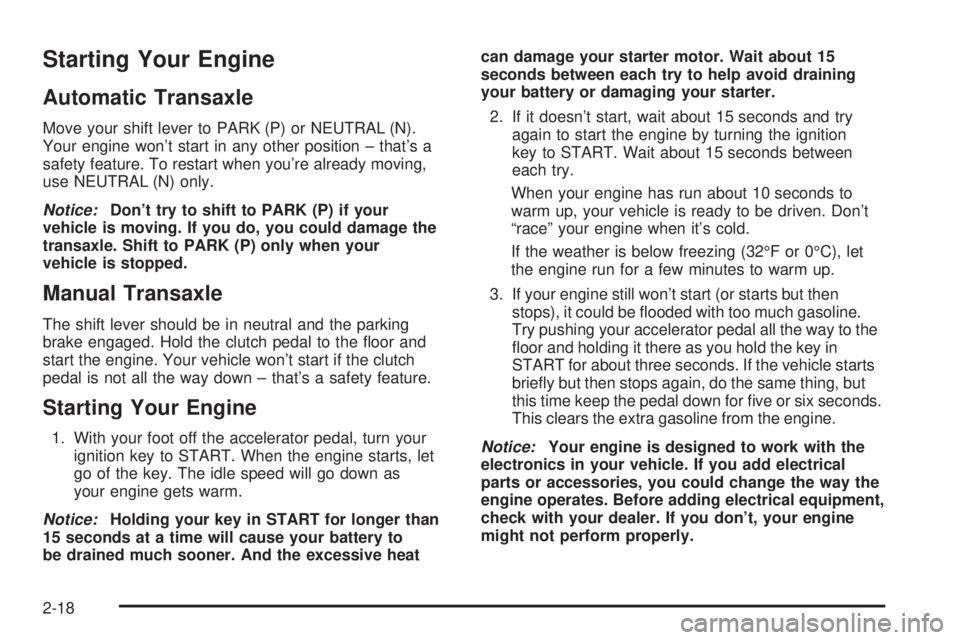
Starting Your Engine
Automatic Transaxle
Move your shift lever to PARK (P) or NEUTRAL (N).
Your engine won't start in any other position ± that's a
safety feature. To restart when you're already moving,
use NEUTRAL (N) only.
Notice:Don't try to shift to PARK (P) if your
vehicle is moving. If you do, you could damage the
transaxle. Shift to PARK (P) only when your
vehicle is stopped.
Manual Transaxle
The shift lever should be in neutral and the parking
brake engaged. Hold the clutch pedal to the ¯oor and
start the engine. Your vehicle won't start if the clutch
pedal is not all the way down ± that's a safety feature.
Starting Your Engine
1. With your foot off the accelerator pedal, turn your
ignition key to START. When the engine starts, let
go of the key. The idle speed will go down as
your engine gets warm.
Notice:Holding your key in START for longer than
15 seconds at a time will cause your battery to
be drained much sooner. And the excessive heatcan damage your starter motor. Wait about 15
seconds between each try to help avoid draining
your battery or damaging your starter.
2. If it doesn't start, wait about 15 seconds and try
again to start the engine by turning the ignition
key to START. Wait about 15 seconds between
each try.
When your engine has run about 10 seconds to
warm up, your vehicle is ready to be driven. Don't
ªraceº your engine when it's cold.
If the weather is below freezing (32ÉF or 0ÉC), let
the engine run for a few minutes to warm up.
3. If your engine still won't start (or starts but then
stops), it could be ¯ooded with too much gasoline.
Try pushing your accelerator pedal all the way to the
¯oor and holding it there as you hold the key in
START for about three seconds. If the vehicle starts
brie¯y but then stops again, do the same thing, but
this time keep the pedal down for ®ve or six seconds.
This clears the extra gasoline from the engine.
Notice:Your engine is designed to work with the
electronics in your vehicle. If you add electrical
parts or accessories, you could change the way the
engine operates. Before adding electrical equipment,
check with your dealer. If you don't, your engine
might not perform properly.
2-18
Page 85 of 370
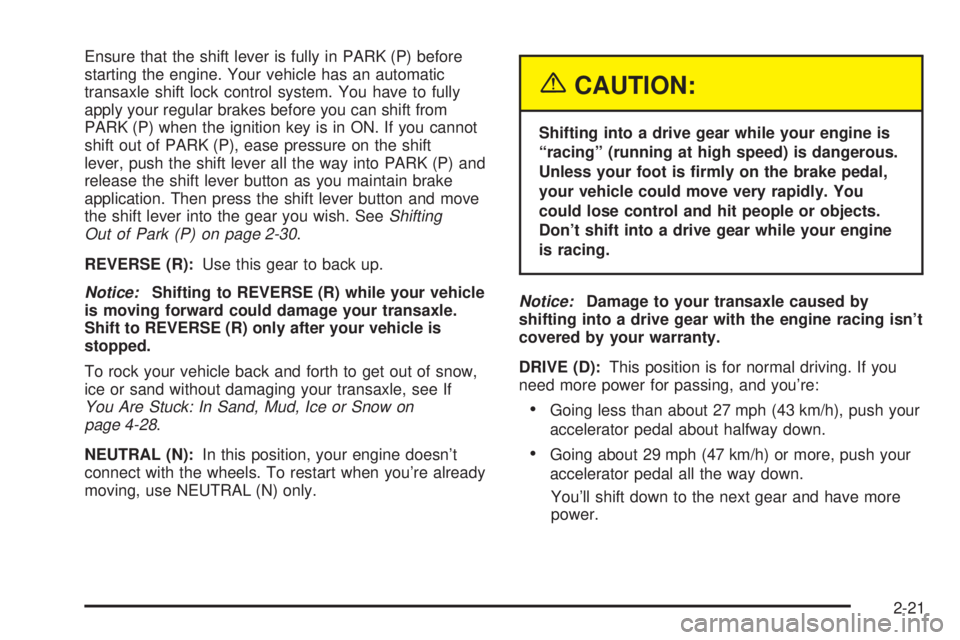
Ensure that the shift lever is fully in PARK (P) before
starting the engine. Your vehicle has an automatic
transaxle shift lock control system. You have to fully
apply your regular brakes before you can shift from
PARK (P) when the ignition key is in ON. If you cannot
shift out of PARK (P), ease pressure on the shift
lever, push the shift lever all the way into PARK (P) and
release the shift lever button as you maintain brake
application. Then press the shift lever button and move
the shift lever into the gear you wish. See
Shifting
Out of Park (P) on page 2-30.
REVERSE (R):Use this gear to back up.
Notice:Shifting to REVERSE (R) while your vehicle
is moving forward could damage your transaxle.
Shift to REVERSE (R) only after your vehicle is
stopped.
To rock your vehicle back and forth to get out of snow,
ice or sand without damaging your transaxle, see If
You Are Stuck: In Sand, Mud, Ice or Snow on
page 4-28.
NEUTRAL (N):In this position, your engine doesn't
connect with the wheels. To restart when you're already
moving, use NEUTRAL (N) only.
{CAUTION:
Shifting into a drive gear while your engine is
ªracingº (running at high speed) is dangerous.
Unless your foot is ®rmly on the brake pedal,
your vehicle could move very rapidly. You
could lose control and hit people or objects.
Don't shift into a drive gear while your engine
is racing.
Notice:Damage to your transaxle caused by
shifting into a drive gear with the engine racing isn't
covered by your warranty.
DRIVE (D):This position is for normal driving. If you
need more power for passing, and you're:
·Going less than about 27 mph (43 km/h), push your
accelerator pedal about halfway down.
·Going about 29 mph (47 km/h) or more, push your
accelerator pedal all the way down.
You'll shift down to the next gear and have more
power.
2-21
Page 86 of 370
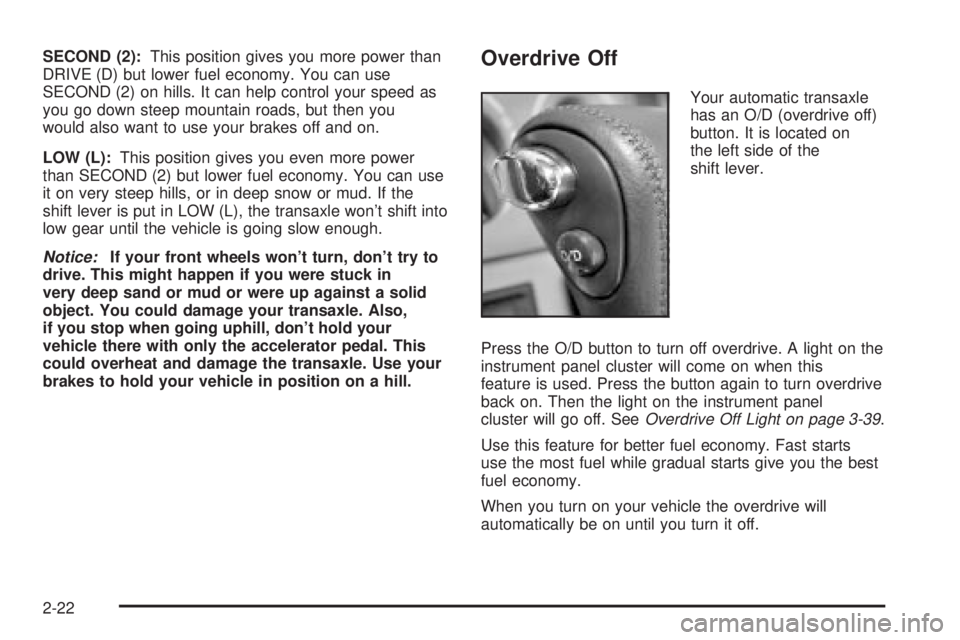
SECOND (2):This position gives you more power than
DRIVE (D) but lower fuel economy. You can use
SECOND (2) on hills. It can help control your speed as
you go down steep mountain roads, but then you
would also want to use your brakes off and on.
LOW (L):This position gives you even more power
than SECOND (2) but lower fuel economy. You can use
it on very steep hills, or in deep snow or mud. If the
shift lever is put in LOW (L), the transaxle won't shift into
low gear until the vehicle is going slow enough.
Notice:If your front wheels won't turn, don't try to
drive. This might happen if you were stuck in
very deep sand or mud or were up against a solid
object. You could damage your transaxle. Also,
if you stop when going uphill, don't hold your
vehicle there with only the accelerator pedal. This
could overheat and damage the transaxle. Use your
brakes to hold your vehicle in position on a hill.
Overdrive Off
Your automatic transaxle
has an O/D (overdrive off)
button. It is located on
the left side of the
shift lever.
Press the O/D button to turn off overdrive. A light on the
instrument panel cluster will come on when this
feature is used. Press the button again to turn overdrive
back on. Then the light on the instrument panel
cluster will go off. See
Overdrive Off Light on page 3-39.
Use this feature for better fuel economy. Fast starts
use the most fuel while gradual starts give you the best
fuel economy.
When you turn on your vehicle the overdrive will
automatically be on until you turn it off.
2-22
Page 87 of 370
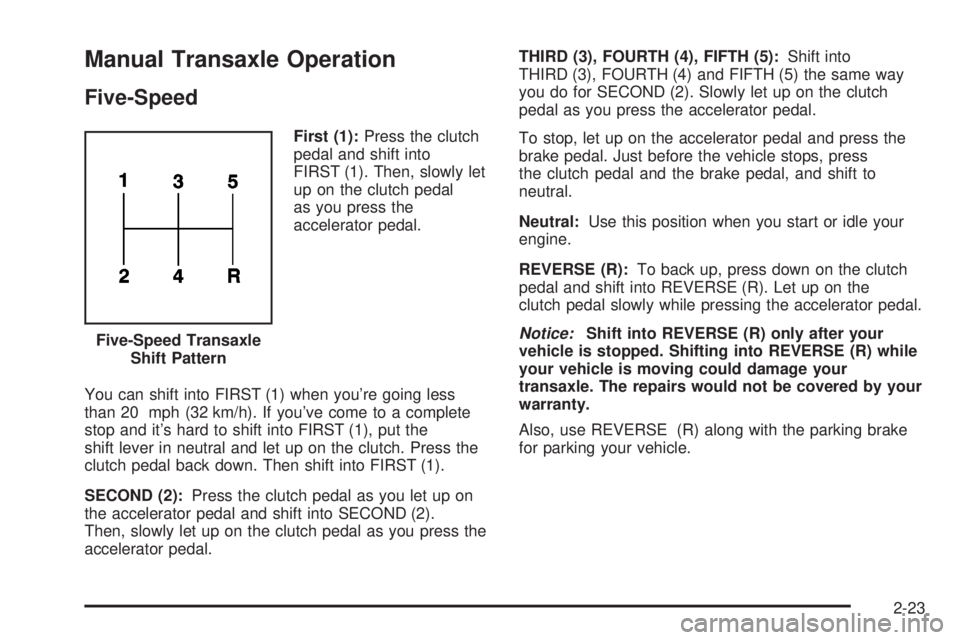
Manual Transaxle Operation
Five-Speed
First (1):Press the clutch
pedal and shift into
FIRST (1). Then, slowly let
up on the clutch pedal
as you press the
accelerator pedal.
You can shift into FIRST (1) when you're going less
than 20 mph (32 km/h). If you've come to a complete
stop and it's hard to shift into FIRST (1), put the
shift lever in neutral and let up on the clutch. Press the
clutch pedal back down. Then shift into FIRST (1).
SECOND (2):Press the clutch pedal as you let up on
the accelerator pedal and shift into SECOND (2).
Then, slowly let up on the clutch pedal as you press the
accelerator pedal.THIRD (3), FOURTH (4), FIFTH (5):Shift into
THIRD (3), FOURTH (4) and FIFTH (5) the same way
you do for SECOND (2). Slowly let up on the clutch
pedal as you press the accelerator pedal.
To stop, let up on the accelerator pedal and press the
brake pedal. Just before the vehicle stops, press
the clutch pedal and the brake pedal, and shift to
neutral.
Neutral:Use this position when you start or idle your
engine.
REVERSE (R):To back up, press down on the clutch
pedal and shift into REVERSE (R). Let up on the
clutch pedal slowly while pressing the accelerator pedal.
Notice:Shift into REVERSE (R) only after your
vehicle is stopped. Shifting into REVERSE (R) while
your vehicle is moving could damage your
transaxle. The repairs would not be covered by your
warranty.
Also, use REVERSE (R) along with the parking brake
for parking your vehicle. Five-Speed Transaxle
Shift Pattern
2-23
Page 89 of 370
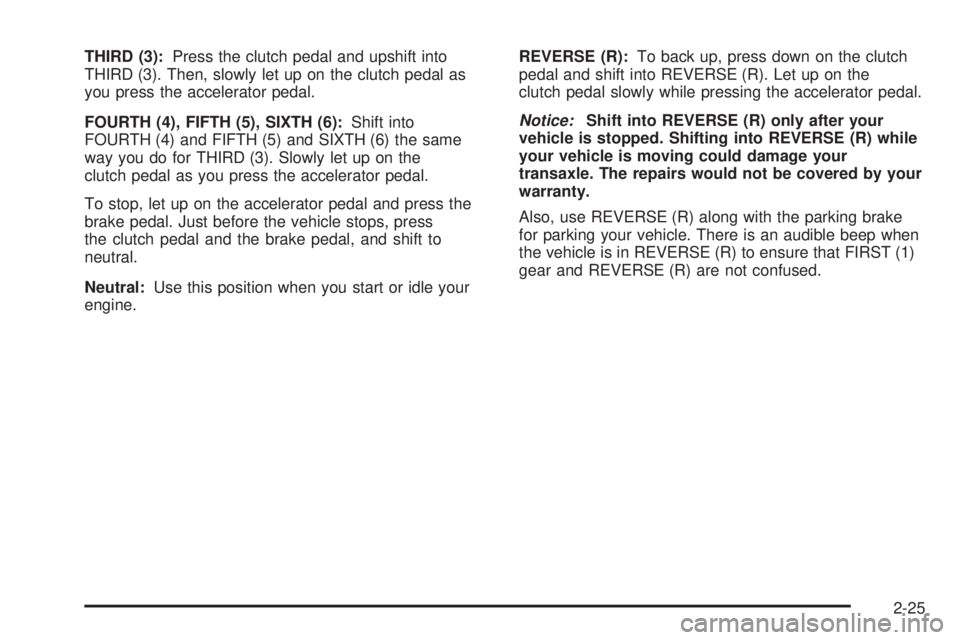
THIRD (3):Press the clutch pedal and upshift into
THIRD (3). Then, slowly let up on the clutch pedal as
you press the accelerator pedal.
FOURTH (4), FIFTH (5), SIXTH (6):Shift into
FOURTH (4) and FIFTH (5) and SIXTH (6) the same
way you do for THIRD (3). Slowly let up on the
clutch pedal as you press the accelerator pedal.
To stop, let up on the accelerator pedal and press the
brake pedal. Just before the vehicle stops, press
the clutch pedal and the brake pedal, and shift to
neutral.
Neutral:Use this position when you start or idle your
engine.REVERSE (R):To back up, press down on the clutch
pedal and shift into REVERSE (R). Let up on the
clutch pedal slowly while pressing the accelerator pedal.
Notice:Shift into REVERSE (R) only after your
vehicle is stopped. Shifting into REVERSE (R) while
your vehicle is moving could damage your
transaxle. The repairs would not be covered by your
warranty.
Also, use REVERSE (R) along with the parking brake
for parking your vehicle. There is an audible beep when
the vehicle is in REVERSE (R) to ensure that FIRST (1)
gear and REVERSE (R) are not confused.
2-25
Page 113 of 370

Windshield Wipers
The lever on the right side of the steering column
controls the windshield wipers and washer.
The available positions are the following:
OFF:The wipers are off.
INT (Intermittent):Move the lever to INT to choose a
delayed wiping cycle. In light rain or snow, you might
want to use this position rather than continuous wiping.
You can change the time between wipes by turning
the INT TIME band. Turn the band forward or rearward
for longer or shorter delay interval.LO (Low):Move the lever to LO for steady wiping at
low speed.
HI (High):Move the lever to HI for steady wiping at
high speed.
MIST:For a single wiping cycle, turn the band to MIST.
Hold it there until the wipers start, then let go. The
wipers will stop after one wipe.
REAR:To turn on the rear window wiper, twist the end
of the lever upward. The wiper does not work with
the rear liftglass open.
Be sure to clear ice and snow from the wiper blades
before using them. If they're frozen to the windshield,
carefully loosen or thaw them. If your blades do become
damaged, get new blades or blade inserts.
Heavy snow or ice can overload your wipers. A circuit
breaker will stop them until the motor cools. Clear away
snow or ice to prevent an overload.
3-7
Page 137 of 370
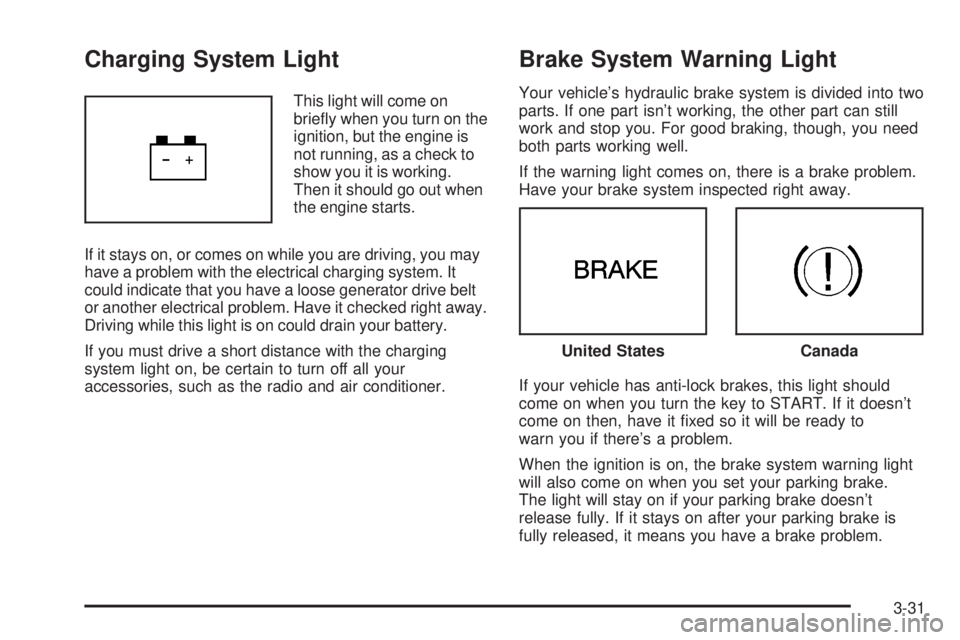
Charging System Light
This light will come on
brie¯y when you turn on the
ignition, but the engine is
not running, as a check to
show you it is working.
Then it should go out when
the engine starts.
If it stays on, or comes on while you are driving, you may
have a problem with the electrical charging system. It
could indicate that you have a loose generator drive belt
or another electrical problem. Have it checked right away.
Driving while this light is on could drain your battery.
If you must drive a short distance with the charging
system light on, be certain to turn off all your
accessories, such as the radio and air conditioner.
Brake System Warning Light
Your vehicle's hydraulic brake system is divided into two
parts. If one part isn't working, the other part can still
work and stop you. For good braking, though, you need
both parts working well.
If the warning light comes on, there is a brake problem.
Have your brake system inspected right away.
If your vehicle has anti-lock brakes, this light should
come on when you turn the key to START. If it doesn't
come on then, have it ®xed so it will be ready to
warn you if there's a problem.
When the ignition is on, the brake system warning light
will also come on when you set your parking brake.
The light will stay on if your parking brake doesn't
release fully. If it stays on after your parking brake is
fully released, it means you have a brake problem.
United StatesCanada
3-31